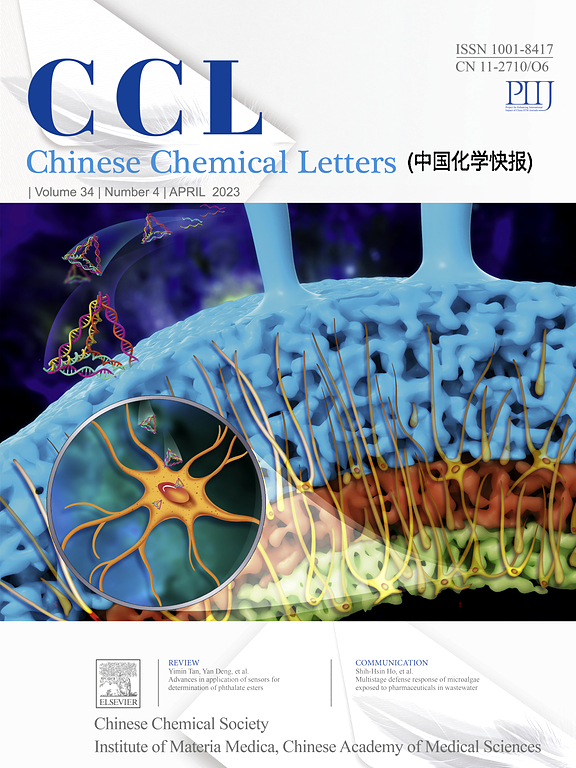Graded nitro-engineering strategy: Tuning surface states and sp² conjugated domains of carbon quantum dots for full-color emission
IF 8.9
1区 化学
Q1 CHEMISTRY, MULTIDISCIPLINARY
引用次数: 0
Abstract
Precise control of luminescence in carbon quantum dots (CQDs), from single-color to full-color emission, is crucial for advancing their applications in biomedical imaging and display technologies. While CQDs luminescence is primarily influenced by conjugated domains and surface states, the underlying interaction mechanisms remain poorly understood. This study explores a graded nitro-engineering approach to simultaneously regulate surface states and sp² conjugated domains through nitro (-NO2) modulation, enabling comprehensive color tuning. Using o-phenylenediamine (o-PD) as the carbon source and adjusting nitric acid (HNO3) concentrations, we synthesized tricolor-emitting nitro-functionalized CQDs (NO₂-CQDs). At lower -NO2 concentrations, luminescence is mainly influenced by surface states, where the electron-withdrawing effect of -NO2 enhances π-electron delocalization and stabilizes sp² conjugation. With increasing -NO2 content, the lowest unoccupied molecular orbital (LUMO) energy level decreases (-2.12 eV to -3.39 eV), resulting in a red-shift in fluorescence. At higher -NO2 concentrations, luminescence is primarily affected by the sp² conjugated domain, where steric hindrance reduces molecular planarity and conjugation, leading to a blue-shift in fluorescence as the sp² domain size decreases (4.03 nm to 2.83 nm). Combining experimental results with density functional theory (DFT) calculations, we reveal the dual role of -NO₂ in modulating CQDs luminescence, an approach rarely achieved through surface functionalization. This work presents a novel strategy for precise tuning of CQDs luminescence across the visible spectrum.

梯度氮工程策略:调整碳量子点的表面态和sp²共轭畴,用于全彩发射
精确控制碳量子点(CQDs)的发光,从单色到全色发射,对于推进其在生物医学成像和显示技术中的应用至关重要。虽然CQDs的发光主要受共轭结构域和表面态的影响,但其潜在的相互作用机制仍然知之甚少。本研究探索了一种梯度硝基工程方法,通过硝基(-NO2)调制同时调节表面态和sp²共轭畴,实现全面的颜色调节。以邻苯二胺(o-PD)为碳源,调节硝酸(HNO3)浓度,合成了三色发光的硝基功能化CQDs (NO₂-CQDs)。在较低的-NO2浓度下,发光主要受表面态的影响,其中-NO2的吸电子效应增强了π-电子离域,稳定了sp²共轭。随着-NO2含量的增加,最低未占据分子轨道(LUMO)能级降低(-2.12 eV至-3.39 eV),导致荧光红移。在较高的-NO2浓度下,发光主要受sp²共轭结构域的影响,其中空间位阻降低了分子的平面度和共轭性,导致荧光蓝移,随着sp²结构域尺寸的减小(4.03 nm至2.83 nm)。结合实验结果和密度泛函理论(DFT)计算,我们揭示了-NO₂在调制CQDs发光中的双重作用,这是一种很少通过表面功能化实现的方法。这项工作提出了一种精确调谐CQDs在可见光谱上发光的新策略。
本文章由计算机程序翻译,如有差异,请以英文原文为准。
求助全文
约1分钟内获得全文
求助全文
来源期刊

Chinese Chemical Letters
化学-化学综合
CiteScore
14.10
自引率
15.40%
发文量
8969
审稿时长
1.6 months
期刊介绍:
Chinese Chemical Letters (CCL) (ISSN 1001-8417) was founded in July 1990. The journal publishes preliminary accounts in the whole field of chemistry, including inorganic chemistry, organic chemistry, analytical chemistry, physical chemistry, polymer chemistry, applied chemistry, etc.Chinese Chemical Letters does not accept articles previously published or scheduled to be published. To verify originality, your article may be checked by the originality detection service CrossCheck.
 求助内容:
求助内容: 应助结果提醒方式:
应助结果提醒方式:


